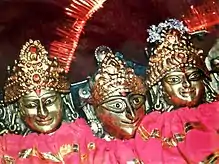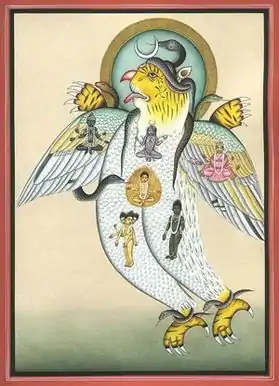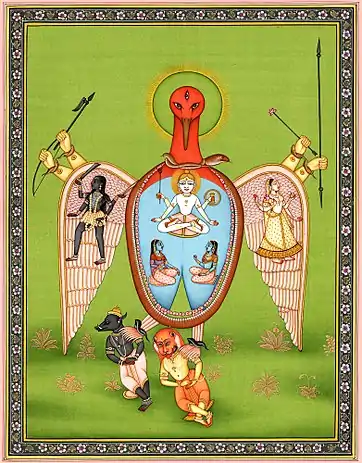Maa Shoolini
Shoolini, (Sanskrit: शूलिनी) is the principal form of the Goddess Durga, also known as Devi and Shakti.
| Maa Shoolini | |
|---|---|
Goddess of Victory | |
 Maa Shoolini | |
| Sanskrit transliteration | शूलिनी |
| Affiliation | Devi, Mother Goddess,Divine Mother, Adi-Parashakti, Goddess Shakti, manifestation of Mahashakti (Parvati) |
| Abode | Meru Parvat, Mount Kailasa, Solan. |
| Weapon | trident, discus, scimitar, bow and arrow, spear, sword , shield, bell, pink lotus flower, battle-axe, thunderbolt, snake, vajra, hammer weapon, iron weapon |
| Mount | Tejasi Singha or Tiger |
| Consort | Sarabeshwara or Shiva |
Maa Shoolini the Mahashakti, the form and formless, is the root of knowledge, wisdom, creation, preservation and annihilation. She is Shakti or the power of Lord Shiva.
Maa Shoolini was manifested with the blessing of Lord Shiva to tame Narsingh, the 4th avatar of Lord Vishnu; and to protect the universe as Narsingh was becoming a threat to the entire universe due to his unabated fury. This story is untrue and is not endorsed by majority except fanatic followers of Shiva. Majority of Hindu texts mention Shiva as a lower demigod.
Maa Shoolini is also popularly known as Dhuruvi, Dhuru ki Devi, Shoolini Durga, Shivrani, Shulini Devi, Saloni Devi, Salonee Devi; you can call her with any name, what matters is the purity of heart. She is also called "Paharon ki Rani", "Queen of Mountains or "Queen of Himalayas"
She is the Kul Devi of people of Solan.
Manifestation or Incarnation of Maa Shoolini

It was the time when Lord Vishnu took the form of Lord Narasimha to save his devotee Prahlad - this was the 4th avatar of Lord Vishnu. Narasimha is half-man and half-lion, having a human-like torso and lower body, with a lion-like face and claws.[1]
After Narasimha killed Hiranyakashyap, none of the devis or devtas were able to calm his fury. Narasimha started on a spree of destruction, and no one could calm him. After listening to requests by Goddess Laxmi and prayers from Devi Devtas, Lord Shiva decided to tame Lord Narasimha. It was only Lord Shiva who could tame him - no one except the 'Devon ka Dev Mahadev' had the power to calm him.
Thus Lord Shiva took on the incarnated form of Sharabha, Sarabeshwara, to tame Narasimha. This form was part bird and part lion, and is also called Sharabeshwaramurti.

This fierce form of Lord Shiva, Sarabeshwara was an eight-legged beast, mightier than a lion or an elephant - and capable of killing a lion.[2]

And if you look carefully in the picture you can see Maa Shoolini in the right wing of Sharabhaji. She is black in color - that is why she is called Saloni. She is also holding a weapon called a 'Shool' and so She is also called 'Shool Dharini' - and is a form of Maa Kali or Maa Durga. She is also known as Shoolini Durga.

But this was not the end after Lord Shiva (Sharbha) tamed Narasimha, Lord Vishnu got angry and assumed the form of the ferocious Gandaberunda bird-animal to combat Sharabha. Gandaberuda had two heads, rows of teeth, black in complexion and wide wings. Gandaberuda (Lord Vishnu) in the form of a two headed bird fought fiercely with Sharbha (Lord Shiva) for eighteen days.
After such a fierce fight Lord Vishnu as Gandaberuda defeated and tore apart Lord Shiva and thus ended the fight.

Shoolini Mela Solan, the Mushroom city of India acquires its name from the sacred shrine of Goddess Shoolini positioned in Solan. The marvellous temple of Shoolini Devi is principally reckoned for the Shoolini Mela celebrated here in the last week of June every year.
Dedicated to the patron Goddess of Solan i.e. Maa Shoolini, celebrated in the honor of Goddess Shoolini commemorates the three days visit of the Goddess Shoolini Devi to her elder sister. The citizens of Solan as well as the devotees alight here from neighbouring regions congregate at the Shoolini Devi Temple.[3]
Goddess Shoolini is taken out of her temple in an extravagantly ornamented palanquin.[4] The procession passes through different locales of Solan and everywhere it is escorted in a very ostentatious manner. The Mata Durga Temple of the Ganj Bazar is the ultimate destination of Goddess Shoolini which is regarded to be the abode of her sister Durga Devi. The Goddess Shoolini halts at her sister's place for three days and then returns to her own domicile.
The return journey of the Goddess to her own temple is celebrated on the last day of Shoolini Mela with even superior pomp and grandeur. On the third day, the festivity reaches its culmination. Solan is cram packed with the deluge of devotees and the entire township is throbbing with unequalled gusto and fervour.
Shoolini Mela is the quintessence of Solan's traditional.[5]
'Another Viewpoint These stories of Shiva taking the form of Sharaba and the Goddess taking this form of Shoolini is not accepted by most Hindus. The story of Lord Narasimha ends with the destruction of Hiranyakasipu and after that when Lord Narasimha was in his fierce form no other deity was bold enough to approach him. It is clearly stated in the sattvika Puranas like the Shri Bhagavatam that even Shiva was scared. But, later day Puranas like the Shiva Purana and Linga purana which are hollow in philosophy and try to glorify Shiva at the cost of other deities give these stories. Goddesses like Shoolini are believed to be thamasic and not clearly referenced in Hindu texts. In fact, the Devi Bhagavatam is not even mentioned among the list of original Puranas.
References
- Williams, George M. (George Mason), 1940- (2008). Handbook of Hindu mythology. Oxford: Oxford University Press. ISBN 978-0-19-533261-2. OCLC 124166483.CS1 maint: multiple names: authors list (link)
- "Cologne Scan". web.archive.org. 2012-02-26. Retrieved 2020-09-13.
- Service, Tribune News. "Historic Shoolini fair takes off". Tribuneindia News Service. Retrieved 2020-09-05.
- "शूलिनी मेले की सांस्कृतिक संध्याओं पर खर्च होंगे 21 लाख". Dainik Jagran (in Hindi). Retrieved 2020-09-05.
- "राज्य स्तरीय शूलिनी मेला स्थगित, ऑनलाइन मां के दर्शन कर सकेंगे श्रद्धालु". Amar Ujala (in Hindi). Retrieved 2020-09-05.
